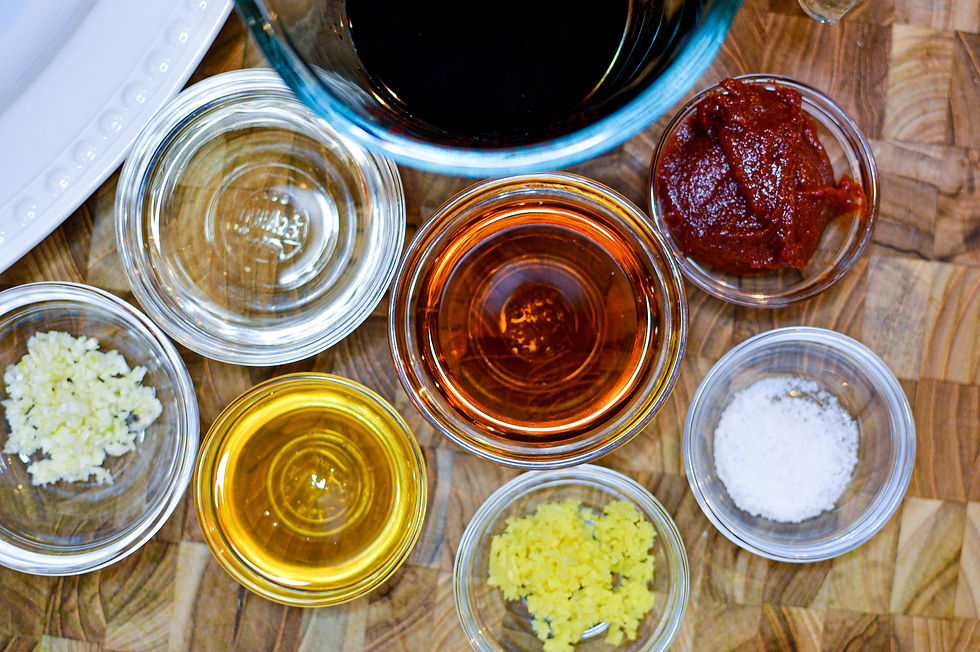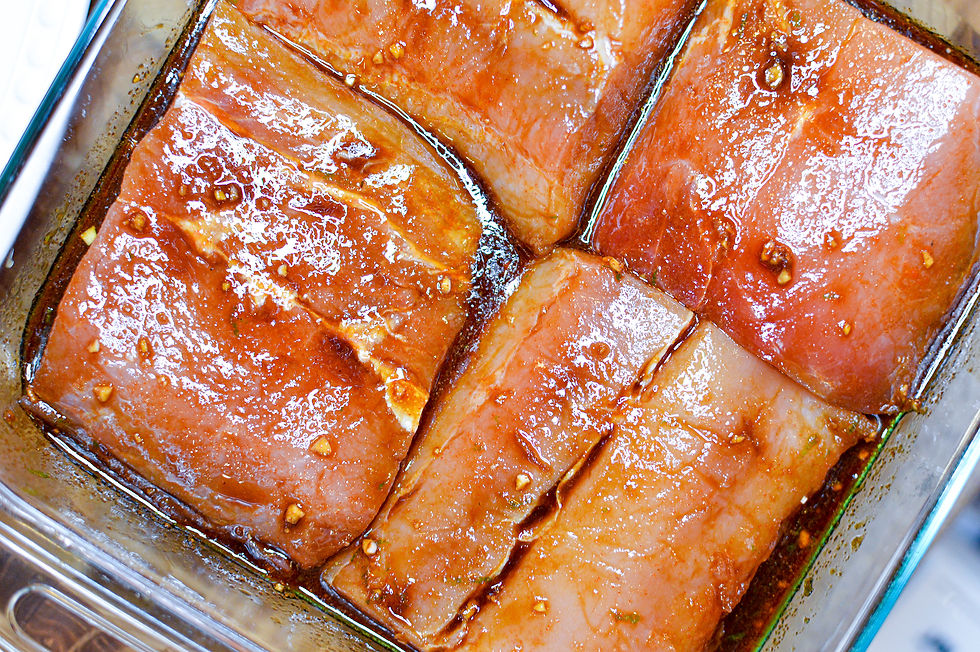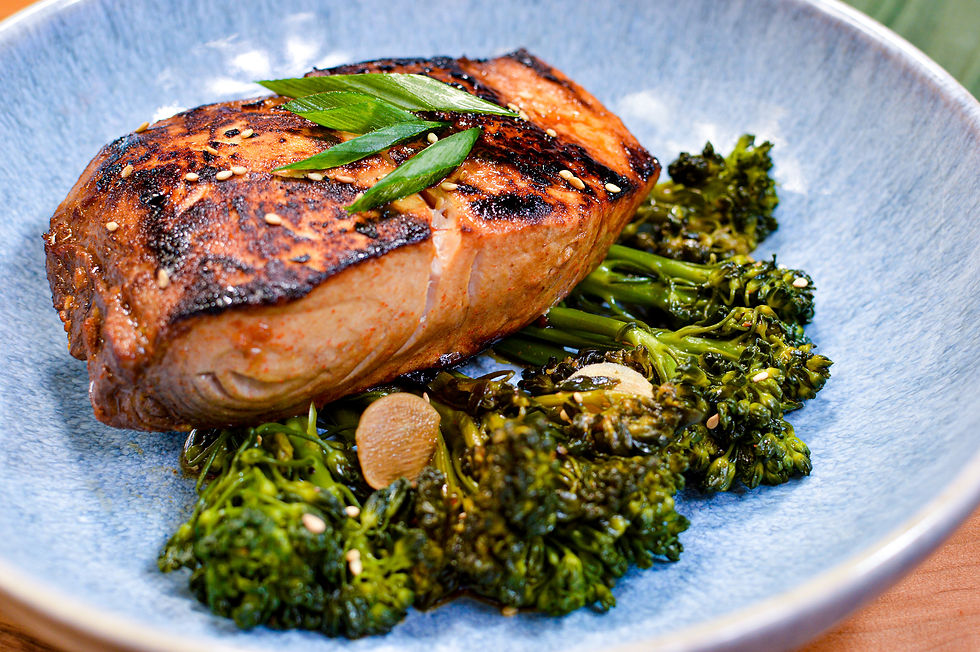GRILLED MAHI-MAHI W/ SOY-GOCHUJANG SAUCE
- WineCheeseScallops

- May 1
- 5 min read
If you’re dreaming of a quick yet flavor-packed dinner that feels a little special, you’re going to love this Grilled Mahi-Mahi with Soy-Gochujang Sauce! 🐟✨ With just a handful of simple ingredients, this recipe creates a savory, slightly sweet, and gently spicy glaze that clings to the perfectly grilled fish. It's ideal for a weeknight dinner but impressive enough for entertaining.

What makes this dish really shine is the beautiful balance between the bold Korean flavors of gochujang and the silky richness of grilled Mahi-Mahi. A sprinkle of green onions and sesame seeds finishes it off with a burst of freshness and crunch. Whether you’re a seafood lover or just craving something different, this recipe is sure to become a favorite!
We’re excited to announce that Wine Cheese Scallops is now an affiliate with Thrive Market! 🎉 By signing up through our special link, you’ll not only help support our blog, but you’ll also score 20% off your order and a $60 free gift! Thrive Market offers amazing organic and sustainable products delivered right to your door. Shop smarter, save big, and enjoy delicious, high-quality ingredients in your home-cooked meals.

Gochujang Paste
Gochujang is a savory, sweet, and spicy fermented Korean condiment made from red chili powder, glutinous rice, fermented soybeans, and salt. Its complex flavor profile adds incredible depth and a gentle heat to any dish. Traditionally used in Korean classics like bibimbap and tteokbokki, gochujang is now loved worldwide for its versatility. It pairs especially well with grilled proteins, lending them a glossy finish and irresistible umami punch.

Mahi-Mahi
Mahi-Mahi, also known as dolphinfish (not related to the dolphin mammal!), is prized for its firm, flaky texture and mild, slightly sweet flavor. It holds up beautifully to grilling, making it a perfect canvas for bold marinades like soy-gochujang. Rich in lean protein and low in fat, Mahi-Mahi is also a great source of vitamins B3, B6, and B12, along with selenium and potassium.
Sponsored Ad

Recipe Origin | GRILLED MAHI-MAHI W/ SOY-GOCHUJANG SAUCE
This recipe was inspired by a spontaneous backyard grilling session where I wanted something beyond the usual barbecue flavors. I had a craving for that distinctive kick you get from Korean dishes, so I whipped up a quick marinade featuring gochujang, soy sauce, and a little honey for balance. The Mahi-Mahi turned out so tender and flavorful that it instantly became a requested favorite for our family dinners! Now, whenever we’re looking for a light yet bold meal that feels special without tons of effort, this grilled fish is our go-to.
Sponsored Ad

Tips, Serving Suggestions, and Storage Advice
Use Fresh Fish: Fresh Mahi-Mahi (or Halibut) will give you the best flavor and texture.
Adjust the Spice: Add more gochujang if you like it spicier, or a little extra honey if you prefer it milder.
Marinate Carefully: Don't marinate the fish for more than an hour — the acids can start to "cook" the fish and change its texture.
Non-Stick Grill Tip: Lightly oil your grill grates or pan to prevent the fish from sticking.
Alternative Fish Choices: This marinade also works great with cod, haddock, or even salmon.

Serve with Sides: Pair the grilled fish with jasmine rice, stir-fried veggies, or a fresh cucumber salad.
Indoor Grilling Option: Use a grill pan on the stovetop if the weather isn’t cooperating.
Leftovers: Store leftover cooked fish in an airtight container in the fridge for up to two days.
Reheat Gently: Reheat leftover fish over low heat to avoid drying it out.
Use Leftover Marinade: Simmer any unused marinade separately to serve as a drizzling sauce (never reuse raw marinade without cooking it first!).
Sponsored Ad


Unique Recipe Qualities
Perfect balance of sweet, salty, and spicy.
Ready in under 30 minutes (plus marinating time).
Uses simple pantry ingredients.
Light, healthy, and packed with protein.
Adaptable to different fish types.
Minimal cleanup required — just one bowl and one grill!
Kid-friendly when you adjust the spice level.
Ideal for warm weather grilling season.
Feels restaurant-quality without being complicated.
Great way to introduce bold Korean flavors to your home cooking.
🎉 Exciting News for Wine Cheese Scallops! 🎉 We’re now officially Amazon Affiliates! If you’re planning any Amazon shopping, you can support our blog just by using our link – no extra cost to you, no matter what you’re buying! 🛒💖
🔗 AMAZON.COM 🔗
So whether it’s kitchen gadgets, books, holiday gifts, or anything else you need, every purchase through our link helps us keep sharing delicious recipes, foodie tips, and restaurant finds! 🌟 Thank you for being part of our journey!
Grilled Mahi-Mahi with Soy-Gochujang Sauce

Ingredients
4 Mahi-Mahi fillets (or halibut/other white fish)
¼ cup soy sauce
2 Tablespoons rice vinegar
2 Tablespoons sesame oil
1 Tablespoon gochujang paste
1 Tablespoon honey
2 cloves garlic, minced
½ teaspoon kosher salt
2 Tablespoons thinly sliced green onions (for garnish)
1 Tablespoon toasted sesame seeds (for garnish)
Instructions
In a large bowl, whisk together the soy sauce, rice vinegar, sesame oil, gochujang paste, honey, minced garlic, and kosher salt.
Add the Mahi-Mahi fillets to the marinade, turning to coat evenly. Cover and refrigerate for at least 30 minutes.
Preheat your grill or a non-stick pan to medium-high heat.
Remove the fillets from the marinade, allowing any excess to drip off.
Grill the fillets for about 3 minutes per side, or until the fish is opaque and flakes easily with a fork.
Transfer the cooked fillets to a serving platter.
Garnish with sliced green onions and toasted sesame seeds before serving.
MUST-HAVE TOOLS FOR THIS RECIPE
We’re so excited for you to try this recipe! To make it even easier, we’ve put together a list of our favorite kitchen tools that are super helpful for this recipe. By using our affiliate links below, you’ll not only be getting top-notch products but also supporting our blog, Wine Cheese Scallops. Thank you so much for your support—happy cooking!
Sponsored Ad

FAQ Section
Q: Can I substitute another fish for Mahi-Mahi?
A: Absolutely! Halibut, cod, or haddock are great alternatives that hold up well to grilling and the bold marinade.
Q: How spicy is the sauce?
A: The heat level is mild to medium. You can adjust it by adding more or less gochujang based on your spice preference.
Q: Can I bake the fish instead of grilling it?
A: Yes! Bake at 400°F for about 10-12 minutes or until the fish flakes easily with a fork.
Q: Is it safe to reuse the marinade as a sauce?
A: Only if you simmer it first to eliminate any bacteria from the raw fish.
Q: How do I toast sesame seeds?
A: Simply add them to a dry skillet over medium heat for a few minutes, shaking often, until golden and fragrant.
Q: Can I make this ahead of time?
A: You can marinate the fish up to 8 hours ahead, but grilling should be done right before serving for best texture.
Q: Does this recipe freeze well?
A: It’s best enjoyed fresh. However, you can freeze raw marinated fillets for up to 1 month and grill them after thawing.
Q: What can I serve with this dish?
A: Great options include jasmine rice, stir-fried vegetables, or a light cucumber and avocado salad.
Q: How do I know when the fish is cooked?
A: The fish should be opaque and flake easily when tested with a fork.
Q: Is gochujang gluten-free?
A: Some brands are, but check the label to be sure, as traditional gochujang may contain wheat.
For the freshest ingredients to recreate dishes like these at home, we always visit our local gem, General Steak and Seafood.
Their high-quality selection never disappoints!
Sponsored Ad









Comments